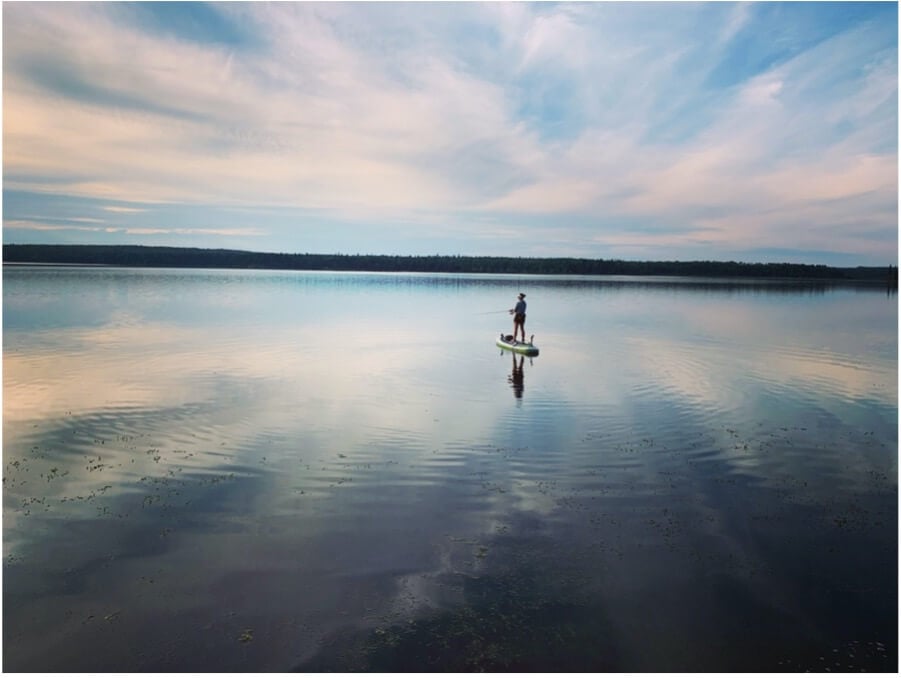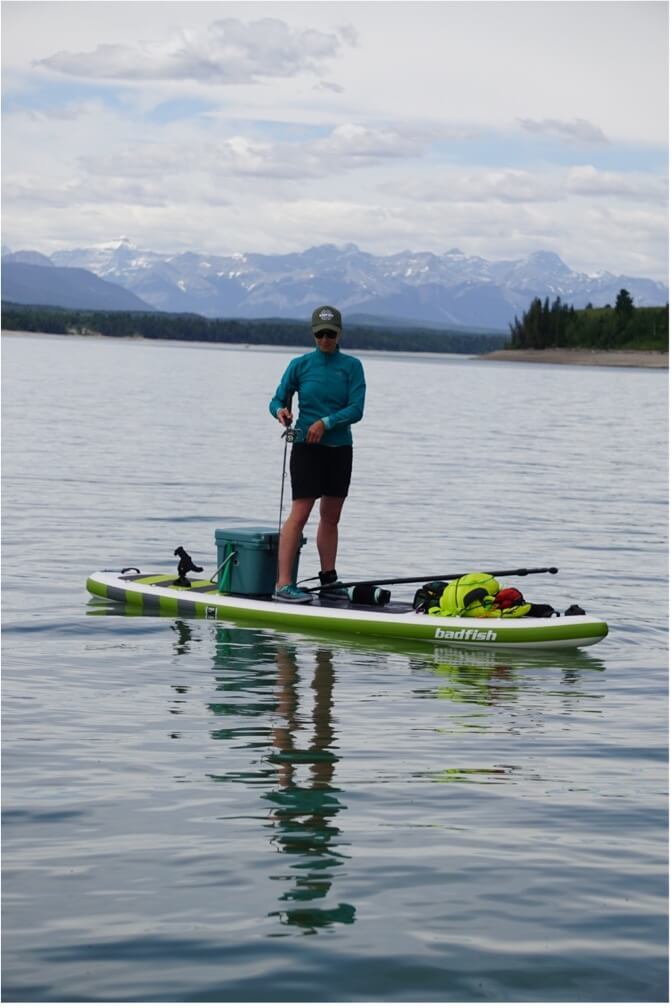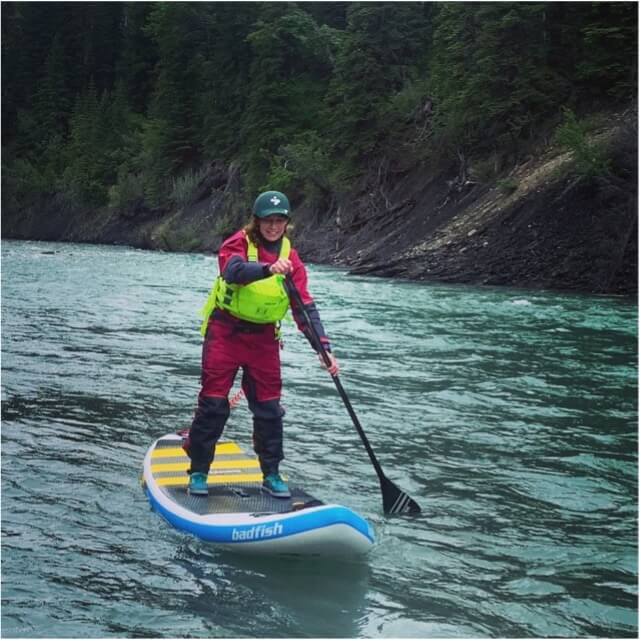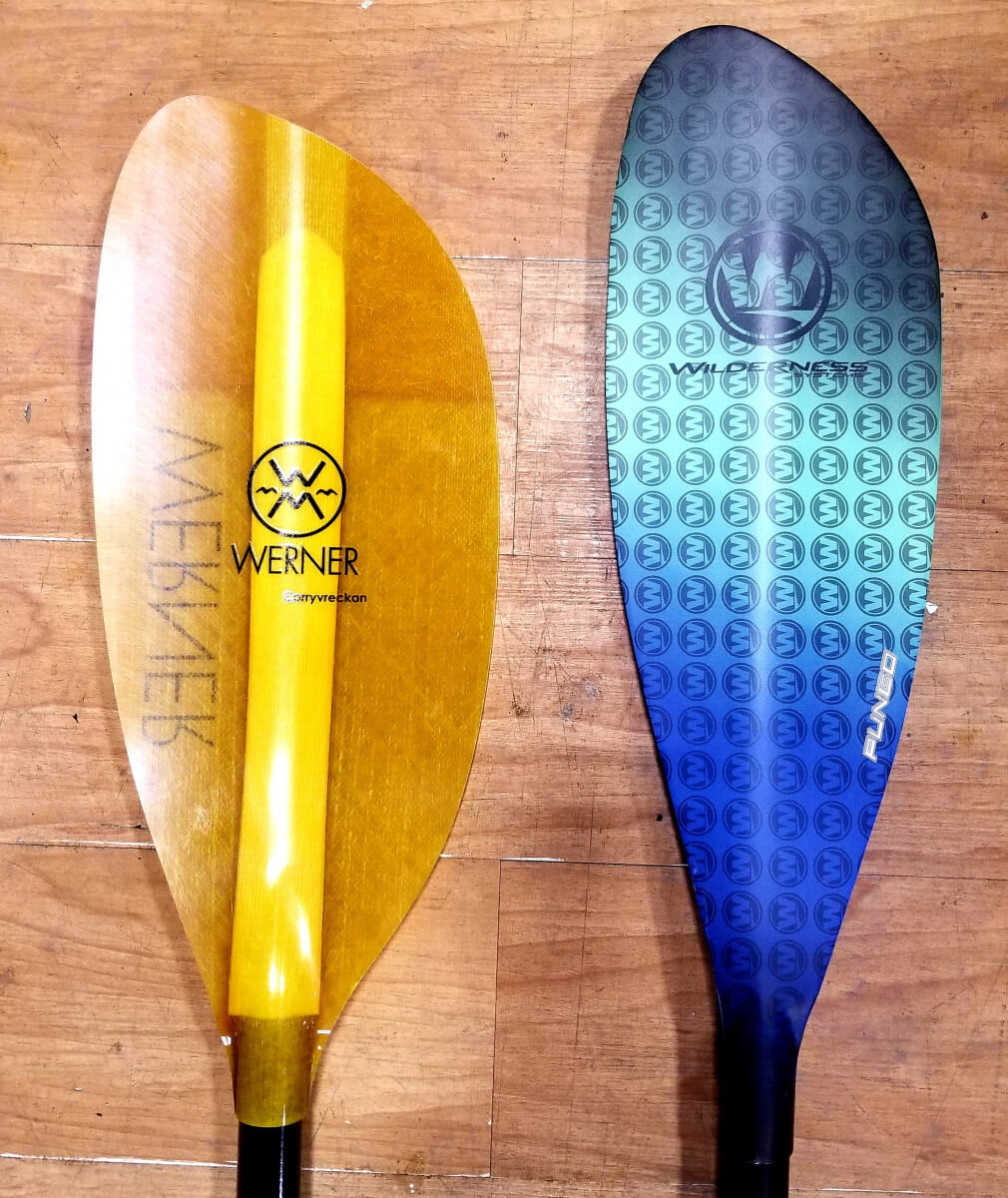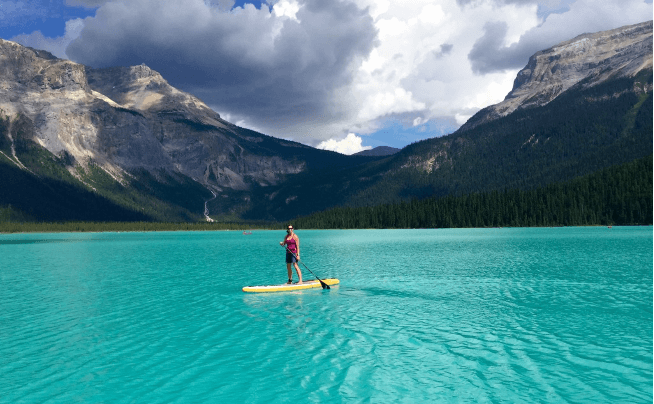WHY SUP FISHING? AREN’T THERE BOATS FOR THAT?
Fishing on your paddle board is a unique experience--similar to our kayak cousins we can glide quietly and gently into areas of lakes that some boats can’t access. It’s a quiet, soul stirring experience.
One of the aspects that I enjoy most of SUP fishing is visibility. I can see fish from far away on my board while standing and often watch them take my hook as they get closer.
Fly fishing is also very accessible on your board: with the ability to stand, and nothing behind you on your back swing, it’s a great place to practice.
SUP Fishing Basics 101: How to Get Started
SUP FISHING FIRST STEPS
Take a Basic Flatwater SUP Course at a minimum. I recommend this before fishing off your SUP. This will ensure you have the basic knowledge regarding safety, paddle strokes and self-rescue.
An Advanced Flatwater Course will allow you to paddle in winds that are much stronger with confidence. As much as we love to paddle on glassed out days as the picture above, the water is a place where conditions change quickly.
STAND UP PADDLEBOARD PRACTICE MAKES PERFECT
Practice your paddling strokes, allowing you to be efficient as you travel across the lake.
Become adept at getting on your board. It's not unusual to get overly excited when you hook that big one and fall off your board.
Be capable of moving from standing to kneeling repeatedly and your transition to fishing is so much easier. Some days I get up and down over a hundred times between taking fish off or changing hooks.
SUP FISHING GEAR
Before we delve into fishing nerd heaven let’s cover safety gear by law required on your SUP.
TRANSPORT CANADA LAW REQUIRES:
PFD & WHISTLE on your person OR
A PFD & WHISTLE on your board AND a 15 M BUOYANT THROW LINE.
LEASH IT OR LOSE IT! ALWAYS WEAR A LEASH WHILE FISHING, IT’S NOT LAW BUT LIFESAVING!
Now that you’re safe and feel comfortable paddling, the fishing fun can begin. One can benefit from having specific paddle boards built for these purposes. However, before you run out and buy a fishing paddle board, rest assured I fished for many years on a standard SUP.
What I fish on now is the Cadillac of fishing SUP’s. The Badfish Badfisher. If you're curious to learn more about this SUP, checkout my Badfish Badfisher SUP Review.
Badfish Badfisher Angler SUP Board

$1,199.00
For a complete review by AQ SUP Ambassador Lisa Stocking, check out: Badfish Badfisher Fishing SUP Review NEW UPDATES Looking for the ultimate adventure platform for fishing? Look no further than AQ Outdoors and the Badfish Badfisher Angler SUP Board.… Read More
It is built for carrying all my equipment, moving around comfortably and attaching my fishing rod holders to via Scotty Mounts.
At the most basic level of fishing enjoyment all you need is:
A fishing rod of your choice spinning, bait caster or fly fishing rod.
Tackle box (fun fact I used a Lululemon shopping bag for years with tackle in it).
Pliers, mouth opener, gloves if you need them, scissors or nail clippers for trimming line.
Tape measure for measuring fish.
Net if you are in lakes with large fish.
Bait if the lake regulations allow it.
Fishing license if required on your waterbody
Weather protective clothing, dependent on fishing near shore close to a dock or moving around a lake.
Water, snacks, sunscreen, bug spray.
WHERE TO FISH FROM YOUR STAND UP PADDLEBOARD?
Asking people where they fish is like asking a woman her weight, you’ll never get a straight answer.
If you notice in many of my pictures, there’s a shoreline present.
This is generally where the majority of your time will be spent: within 100m of shore.
Weed beds, rock shelves, topography changes from shallow to deep are all prime fishing locations.These are usually closer to land mass.
The other reason sticking within sight of shore can be important: weather. You can quickly get off the water if lightning or storms occur.
FISH ON, NOW WHAT?
Many people ask me what I do if I hook onto a big fish, do I get drug around the lake?
I can’t say it hasn’t happened…
Depending on what species you are fishing for I have hooked a large Northern Pike and had it drag me around Pinehurst Lake. In general no, I retrieve the fish with minimal movement.
Another common question: What do you do with your paddle when you catch fish? This can be a cumbersome proposition. Depending on what is on my board I generally set it down between my feet and, if possible, tuck the blade into the bungee cord at the front. No one wants to knock their paddle off and have to retrieve it with a fish on.
You could try a paddle tether that kayak anglers use. I find personally it gets in the way.
When you hook a fish like this walleye in the picture, you’re standing and have more leverage than being seated in a kayak to work the fish.
You can see the fish from a long way away if it is near the surface as your field of vision is much broader being higher up.
As the fish approaches my board and I’m in control of it I kneel down to bring it close to my SUP. You could always kneel down to reel it in as well: it’s your fishing trip and comfort level.
Keeping fish wet is important, be a responsible angler and release them with as much care as possible.
Bring them quickly onto your board if you can’t release the hook from the mouth in the water.
What isn’t fun is when you end up with fish poop on your board, lucky thing for you it’s easy to wash off and let run back into the lake. We’re not kayaks we aren’t going to sink our ship with taking on water.
Keeping a small towel on your board can be handy to wash your hands and board off. My secret is Tow Tabs--just add water, they’re always in my tackle box.
MY ADVANCED SUP FISHING SETUP
Let’s tour my board (The Badfisher) from nose to tail (front to back) covering some of the gear I use on it.
Scotty Mount on the nose: This is great for mounting a camera if you want to capture some awesome fishing moments.
36” Drift Anchor (blue yellow): This is a parachute looking anchor that stops my nose from drifting around. I anchor the back of my board with a 5-10 lb anchor (insider tip an old dumbbell will work to start with). Your anchor needs up to 50 ft of rope with it depending on the depth of lakes you fish.
Dry Bag (Green): rain jacket, sweater, snacks, survival gear (knife, fire starter, striker, matches), first aid kit.
Cabela’s Soft Tackle Box: all my hooks, line, weights and secret weapons are in here.
Scotty Mount: There’s a second mount here which is handy to put my rod in while I change hooks.
Yeti Water Bottle: Keeps my water cold all day or hot if it’s cold out, I love the water bottle holder near the carry handle so easy to access and it holds tight.
Yeti Roadie 20 Cooler: This has been a FANTASTIC game changer, I can sit easily, keep food in here and bait cold.
Scotty Mount: Third mount on this board and where I keep my rod while I paddle out and a great spot to keep it if I’m trolling! Yes, trolling is where you put your line in the water and paddle forward letting the hook do all the work behind the board. I have caught MANY fish this way!
Leash: Leashes saves lives! If you fall off and lose your board because the wind takes it away from you there are two problems now facing you. Hypothermia or drowning.
PLEASE ALWAYS WEAR A LEASH FISHING!
If I was going across the lake to camp overnight I have room behind my cooler to put a dry bag with my gear. I love the Badfisher with its numerous D-ring attachments that allow me to attach so much gear to it! This is a well thought out board design. At 11’ 6” L x 36” W it’s super stable.
SUP FISHING BASICS CONCLUSION
Flaming Gorge Reservoir, Utah
I hope this information assists and inspires you to explore many places with your SUP and ROD!
Happy paddling and fishing!
Sending You Love n SUP,
Lisa Stocking
CSEP-CPT/RYT 200
Advanced Flatwater SUP Instructor
@love_nsup
AQ Outdoors Contact
Edmonton: (p) 780 463-4892 (e) info@aquabaticsedmonton.com
Calgary: (p) 403 288-9283 (e) info@aqoutdoors.com



















































